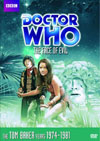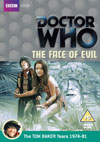DVD Extras include:
"No More Janis Thorns"The Doctor meets Leela quite early in the first episode, and perhaps in large part thanks to her expulsion from the Sevateem tribe, they immediately fall into a typical fully-functioning Doctor/companion routine. It's hard to believe her future as a new full time companion wasn't a certainty from the start. Leela is refreshing in the sense that she's not only eager to jump into new adventures with the Doctor, but she's combat-ready on top of it, often even more so than he is. The Doctor spends much time restraining her, encouraging her to use her mind a little more. She's rather like a low-tech Steven Taylor or Jamie McCrimmon, only more violent. His forbidding her to use any more deadly-poisonous Janis Thorns is an absolutely correct moment.Jameson throws herself into the role really well, and has fun with it. The childlike qualities she exhibits at times help to make the character and her origins that much more believable. Tom Baker also deserves kudos for his insistence on changing a scripted knife into a jelly-baby. Not only does it put the Doctor's character on far greater moral ground, it showcases his talent for brash bluffs and quick thinking, and it's one of the most entertaining and humorous moments in the entire fourteenth season. In fact, it's simply one of THE classic moments of the entire series. Pennant Roberts also makes his debut as director on the show. He often strikes me as being a bit too ambitious for the production limitations imposed on the program. As someone who has struggled to add visual beam lasers to a personal copy of "Warriors of the Deep" (story no. 131, also directed by Roberts), I can attest that the footage Roberts shoots is more suited to expensive post-production at Industrial Light and Magic than the BBC's modest electronic effects of the mid-1970's, with cameras and actors constantly moving gunpoints and targets. While this makes life hard for the post crew, the dynamics in the shots are usually good for the story, so there's always a bit of a trade-off. In "The Face of Evil", Roberts puts his ambition to good use. The film sequences are excellent, particularly as an invisible monster crushes an egg-timer. Roberts also delivers visual beam effects in this story that are quite impressive for the time in which they were done, and notice the movement in the footage during beam effects too, adding extra challenges for the electronic effects supervisor. I'm pleasantly surprised the laser fire of this story turned out as well as it did. The sound effect isn't half as powerful as that of the Gallifreyan weapons from the last story, but it will do. Xoanon's inner chamber is also a very impressive use of CSO effects, helping to emphasize the purely mental and schizophrenic aspects of the story. The program continues to boast one of its oldest strengths here, in using highly creative atmospheric sound to support the story. Other post-production elements are not all they should be; Tom Baker's face at the climax of Part Two goes too easily unnoticed unless one is looking for it - its colour is too similar to the set behind it for it to stand out as it should, and a close-up of it would seem to be a natural addition to help the sequence as well. Other effects seem to be thrown in rather gratuitously: Why do the Doctor and Leela need to glow red before they walk through a false wall on their way to the ship? The jungle set, though not as colourful or elaborate as that for "Planet of Evil" (story no. 81), is equally disappointing for the same reasons. The foreground is lit for day, while the background is black as though it were night. Too bad the budget didn't stretch a little more, to allow for location filming. Using the same spot as used for inside the Matrix in the previous story would have been nice. I even prefer the indoor jungle sets of "Kinda" (story no. 119), because at least the daylight is convincing. "The Face of Evil" is too dark in the jungle. David Garfield, who also appeared in "The War Games" (story no. 50), is particularly enjoyable in this one as Neeva, where he has the unenviable task of balancing rituals and superstitions and power-plays with sudden insight, discovery and mental resistance. Thankfully he pulls it off satisfyingly in the end. Leslie Schofield also makes his character Calib worthy of deeper scrutiny.
"Two Days?! I haven't got time to be lying around for two days!"It is notable and refreshing that the climax happens early in part four, while plenty of time is given to the aftermath of the story, wrapping up all the loose ends at a fairly relaxed and believable pace. Notice how no screen time is devoted to the Man of Sleep while he is sleeping, and no blubber scenes for Leela either. Screen time is for waking, productive moments.
International Titles:Magyar: "A gonosz arca"Français: (Le Visage du démon) Русский: "Лицо зла"
This story is available on DVD & VHS video:
Comments on this article are welcome. You may contact the author from this page:
|








